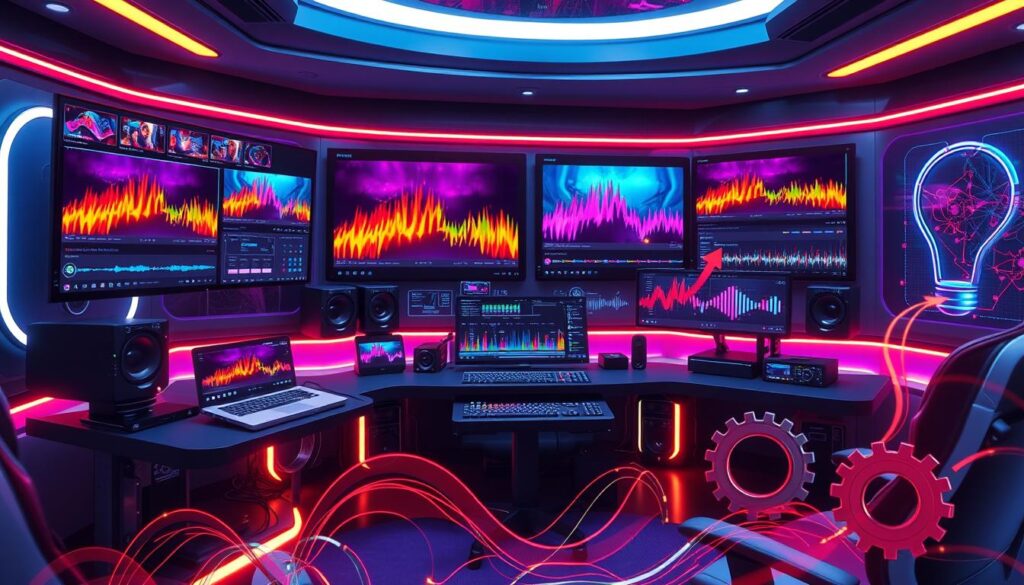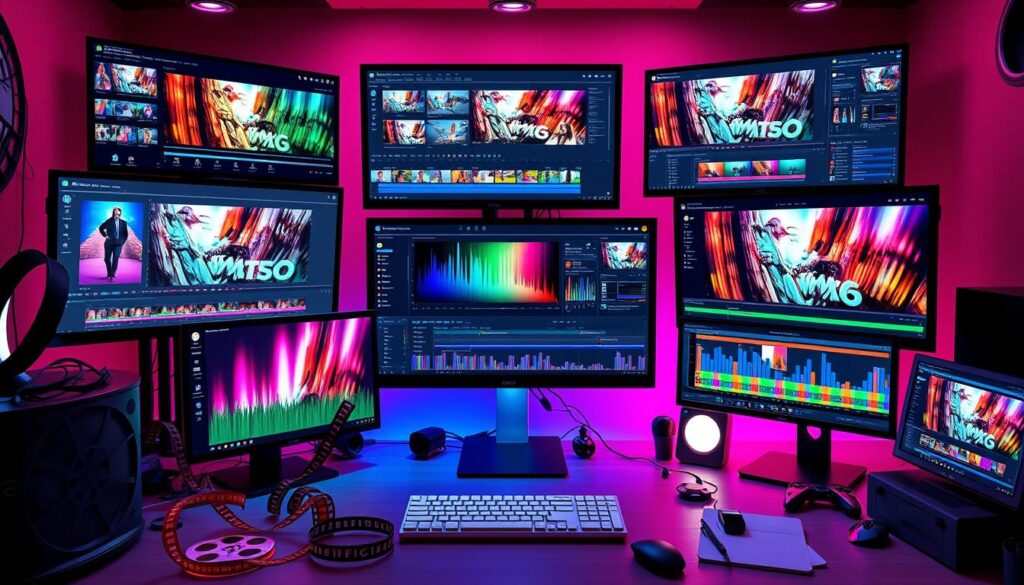In today’s world, video editing is key for creators, filmmakers, and videographers. This guide covers essential techniques to improve your videos. You’ll learn about color grading, transitions, creative effects, and more. These skills will help you make videos that grab your audience’s attention.
Key Takeaways
- Discover the importance of video editing and its impact on storytelling and audience engagement.
- Explore the various types of video editing software and their unique features to find the best fit for your needs.
- Master color grading techniques to enhance the visual aesthetics of your footage.
- Learn how to seamlessly incorporate video transitions to create smooth and cohesive video narratives.
- Incorporate creative video effects to add visual interest and effectively convey your message.
- Understand the significance of audio editing and how it can elevate your video’s emotional impact.
- Delve into the world of motion graphics and video compositing to elevate your production value.
Introduction to Video Editing
Video editing is now a must-have skill in today’s media world. It’s used for social media, promotional videos, and documentaries. Learning to edit videos turns raw footage into engaging stories.
Importance of Video Editing
Video editing is more than just cutting clips. It’s a key step in making videos better. It improves the look and feel of your video, making it more engaging.
Types of Video Editing Software
There are many video editing software options out there. They range from Adobe Premiere Pro and Final Cut Pro to DaVinci Resolve and Avid Media Composer. The right software can make your editing process smoother and your videos better.
- Non-linear editing software: Allows for a more flexible, non-sequential approach to video editing, enabling you to rearrange and modify footage with ease.
- Specialized video editing programs: Offer advanced features and tools for tasks like color grading, motion graphics, and audio editing, providing deeper control over the creative process.
Choosing the right video editing software is important. It should match your needs and skill level. This ensures a smooth and efficient editing process.
Color Grading Techniques
In video editing, color grading is key to making your footage stand out. It changes the color, contrast, and balance to create a unique look. Whether you want a cinematic feel or a vibrant vibe, learning color grading is crucial.
Color correction is a big part of color grading. It fixes the color balance and skin tones. Tools like color wheels, curves, and levels help you adjust the colors for a stunning result.
Color grading also lets you get creative with color manipulation. You can highlight important parts of the frame or create a special mood. Using color-based image masking, color-keying, and color-driven visual effects can help you achieve your vision.
“The power of color grading lies in its ability to transform the mood and tone of a scene, ultimately shaping the narrative and drawing the audience deeper into the story.”
Mastering color grading needs both skill and creativity. By trying out different techniques, you can tell stories in a new way. This will surely grab your audience’s attention.
| Technique | Description | Benefits |
|---|---|---|
| Color Correction | Adjusting the overall color balance, ensuring accurate skin tones, and correcting any color casts or inconsistencies. | Achieves a cohesive and visually consistent look across the footage. |
| Color Manipulation | Selectively altering the colors in specific areas of the frame to draw attention, evoke emotions, or create a unique style. | Allows for more creative and impactful visual storytelling. |
| Color-based Effects | Utilizing techniques like color-based image masking, color-keying, and color-driven visual effects. | Expands the creative possibilities and visual impact of the video. |
Mastering Video Transitions
Seamless video transitions are key to a great video. We’ll look at different video editing transitions and share tips for smooth transitions. These will make your videos stand out.
Types of Video Transitions
The world of video transitions is vast. It offers many options to improve your video’s flow. Here are some common types:
- Cuts: The simplest and most abrupt transition, where one clip immediately follows another.
- Fades: Gradual transitions that smoothly fade in or out, creating a subtle and elegant effect.
- Wipes: Dynamic transitions that appear to “wipe” the screen, revealing the next clip.
- Dissolves: A blend between two clips, creating a seamless connection between scenes.
- Zooms: Transitions that involve a zooming-in or zooming-out effect, adding a sense of movement.
Tips for Smooth Transitions
Mastering video transitions takes skill and thought. Here are tips for smooth transitions:
- Match the pace and energy of your clips: Ensure that the transition tempo aligns with the rhythm of your footage.
- Avoid overusing transitions: Use them judiciously to maintain a natural flow, not as a gimmick.
- Consider the visual context: Choose transitions that complement the visual elements and storytelling of your video.
- Experiment with different types: Explore the wide range of transition effects to find the ones that best suit your project.
- Pay attention to audio: Coordinate your video transitions with any accompanying audio to create a seamless experience.
By following these tips and exploring video editing transitions, you’ll make great videos. Your productions will be captivating and polished.
Creative Video Effects
Adding creative video effects can change your footage in amazing ways. It adds depth, dimension, and visual interest. You can use compositing, animation, and stylized filters to make your videos stand out.
Compositing lets you mix different video layers or elements together. It’s great for adding cool visual effects. For example, you can put a character in a fantasy world or make an object seem to float.
Animation brings your footage to life. You can use animation tools for simple motion graphics or complex sequences. These effects can show emotion, set a mood, or add fun to your videos.
Stylized filters give your videos a unique look. You can use them for a moody, cinematic feel or a retro vibe. These effects change the whole feel of your footage, making it special.
Learning these creative video effects can improve your editing skills. Try out different techniques and see what works best for you. Let your creativity show in your final videos.

| Video Effect | Description | Examples |
|---|---|---|
| Compositing | Blending multiple video layers or elements into a single frame | Inserting characters into fantastical backgrounds, creating the illusion of floating objects |
| Animation | Bringing footage to life through motion graphics and animated sequences | Conveying emotion, establishing mood, adding whimsy |
| Stylized Filters | Infusing videos with a unique aesthetic through color grading and visual effects | Moody, cinematic looks, retro-inspired effects |
“The true magic of video editing lies in the power to transform the ordinary into the extraordinary.”
Audio Editing for Better Storytelling
Creating engaging videos is more than just great visuals. Audio is key to pulling viewers in and making the story better. We’ll look at why audio matters and how to edit it well for your videos.
Importance of Audio in Videos
Audio is the hidden gem of video stories. Good audio can lift a video, setting the mood and guiding the viewer. Bad audio can pull viewers away, hurting your video’s impact.
Good audio editing makes the soundscape better, balances levels, and sounds professional. It makes your video more engaging and immersive for viewers.
Audio Editing Tools and Techniques
There are many tools and techniques to improve your video’s audio. From clear voiceovers to mixing sounds, the right skills can change everything.
- Voiceover recording and editing
- Sound effect integration and layering
- Audio level balancing and normalization
- Noise reduction and sound cleaning
- Ambient sound and background music
Learning these techniques can blend sound and visuals perfectly. This captivates your audience and boosts your video’s storytelling power.
“Great audio can make a good video great, while poor audio can make a great video unwatchable.”
Success in video storytelling depends on combining visuals and audio well. By focusing on audio editing, you can take your videos to the next level and impress your audience.
Video Editing Techniques
As a video editor, knowing various techniques is crucial. It can make your footage stand out and engage your audience. We’ll look at some key video editing techniques to improve your skills and explore new ways to tell stories.
Learning to work with footage is essential. It involves trimming, splicing, and arranging clips for a smooth story. Also, organizing your media well keeps your workflow smooth and your resources easily accessible.
Using keyboard shortcuts is another great tip. Knowing these shortcuts can make editing faster. It lets you focus more on the creative parts of your project.
Finally, using non-destructive editing principles opens up new possibilities. This method lets you try different things without worrying about losing your work. It’s a way to explore and experiment freely.
The Power of Keyboard Shortcuts
Keyboard shortcuts can change how you edit videos. Here are some key ones to learn:
- Cut Clip: Ctrl + X
- Copy Clip: Ctrl + C
- Paste Clip: Ctrl + V
- Undo: Ctrl + Z
- Redo: Ctrl + Y
- Zoom In: Ctrl + +
- Zoom Out: Ctrl + –
Non-Destructive Editing: Unlock Your Creativity
Non-destructive editing is a key video editing best practices. It lets you change things without messing up your original footage. This method has many benefits:
- Flexibility: You can try new things without worrying about mistakes.
- Efficiency: It’s easy to make changes and improve your project.
- Collaboration: You can share your work easily for feedback and updates.
By using these video editing techniques, you can explore new ideas and improve your storytelling.
Motion Graphics and Compositing
In the world of video production, motion graphics and video compositing are key. They help make videos look amazing and engaging. These tools let creators mix different visuals smoothly, making stories better and experiences richer.
Introduction to Motion Graphics
Motion graphics make still images move. Using keyframing, easing, and parenting, experts can turn logos and text into lively visuals. This makes videos more interesting and fun to watch.
Video Compositing Techniques
Video compositing mixes different layers to make a single, great video. It includes green screen removal and chroma keying. It also uses rotoscoping and motion tracking to blend motion graphics, visual effects, and video layering. Learning these skills can make any video better and more engaging.
| Technique | Description |
|---|---|
| Green Screen | Allows for the removal of a solid color background, enabling the integration of subjects into new environments. |
| Chroma Keying | Similar to green screen, but uses a wider range of colors, including blue, to create a transparent background. |
| Rotoscoping | The process of tracing over footage frame by frame to isolate specific elements, such as characters or objects. |
| Motion Tracking | Tracks the movement of objects or subjects within a video, enabling the seamless integration of additional elements. |
Learning motion graphics and video compositing can make videos stand out. It helps creators make stunning visual effects and video layering that grab viewers’ attention.
Video Optimization for Web and Social Media
In today’s digital world, making your videos work well on the web and social media is key. It’s about picking the right formats and using smart compression. Knowing how to optimize your videos can really boost their performance.
Choosing the right video formats is a big part of optimization. Each platform and device likes different formats. The wrong one can make your video look bad. Formats like MP4, WebM, and AVI each have their own good points, so pick the best one for you.
Compression is also super important. It makes your videos smaller without losing too much quality. This means they load faster and work better on all kinds of devices. Using H.264 or VP9 encoding can help you get the best balance.
- Find the best video formats for where you want to share your videos
- Use smart compression to make your videos smaller without losing quality
- Try different video encoding settings to find what works best for you
- Use video optimization tools to make the process easier and get better results
Mastering video optimization means your videos will be ready to shine online. They’ll grab your audience’s attention and get them engaged like never before.
| Video Format | Compression Ratio | Quality | Compatibility |
|---|---|---|---|
| MP4 | High | High | Widespread |
| WebM | High | High | Good |
| AVI | Medium | High | Good |

“The key to successful video optimization is finding the right balance between file size and visual quality, ensuring your content is accessible and engaging on a wide range of platforms and devices.”
Non-Linear Editing: The Modern Approach
In the world of video production, non-linear editing is now the top choice. It has changed how people make and improve their videos. This method is much more flexible and efficient than old ways.
Benefits of Non-Linear Editing
Non-linear editing has opened up new possibilities for video makers. It lets them work in a more flexible way than before. They can easily change the order, cut, and adjust clips to fit their story.
This method also makes it easier to work together. Teams can edit a project together, making the process faster and more collaborative.
Popular Non-Linear Editing Software
Many video editing software options have come up with non-linear editing. Here are some top ones:
- Adobe Premiere Pro – A top digital video editing software known for its advanced features and easy use.
- Final Cut Pro – A favorite among Apple users, it’s known for its focus on teamwork and efficient editing.
- DaVinci Resolve – A full non-linear editing tool that does video editing, color grading, and visual effects well. It’s great for professional video editing.
These tools and others are helping video creators make amazing content. They’re making videos that look great and connect with lots of people.
Multicam Editing for Live Events
Capturing and editing footage from multiple cameras is key for live event videos. This skill is vital for events like concerts, conferences, and sports. It lets you mix footage from different cameras into one cohesive video.
Multicam editing changes the game in live event video production. It lets you capture the event’s energy from various angles. This way, viewers get a more immersive and dynamic experience.
To master multicam editing, you need attention to detail and knowledge of video editing software. It also requires making quick decisions during the event. With multicam editing, video producers can make their live event coverage stand out. They deliver a polished video that captures the event’s essence.



